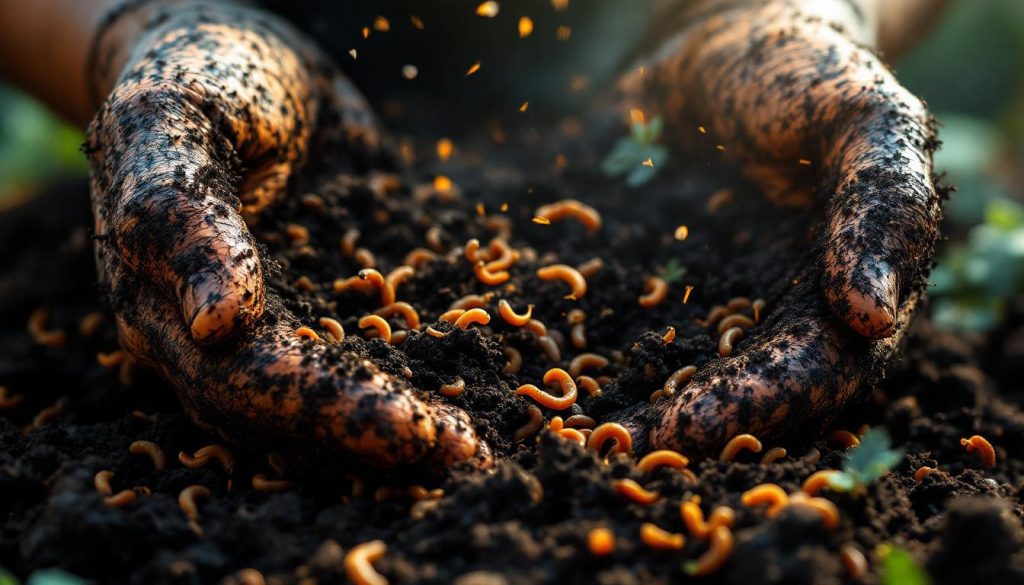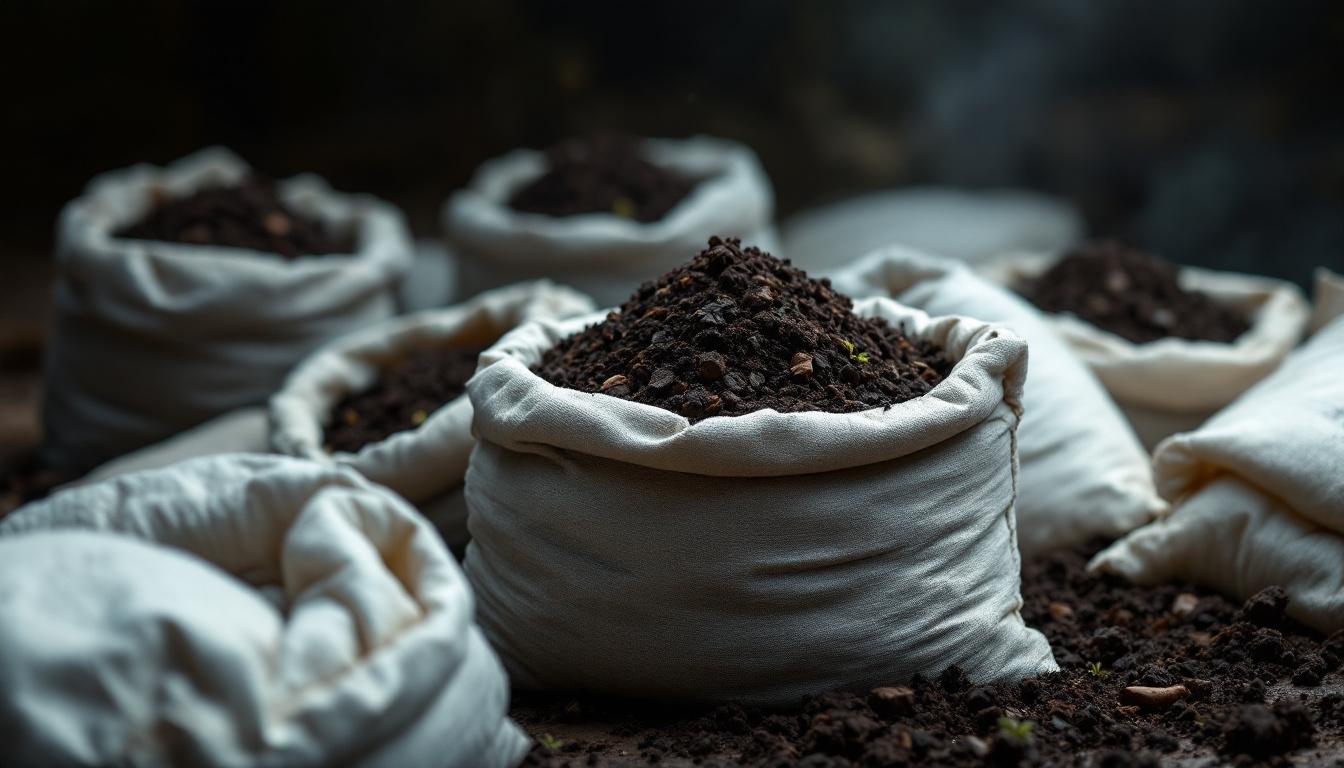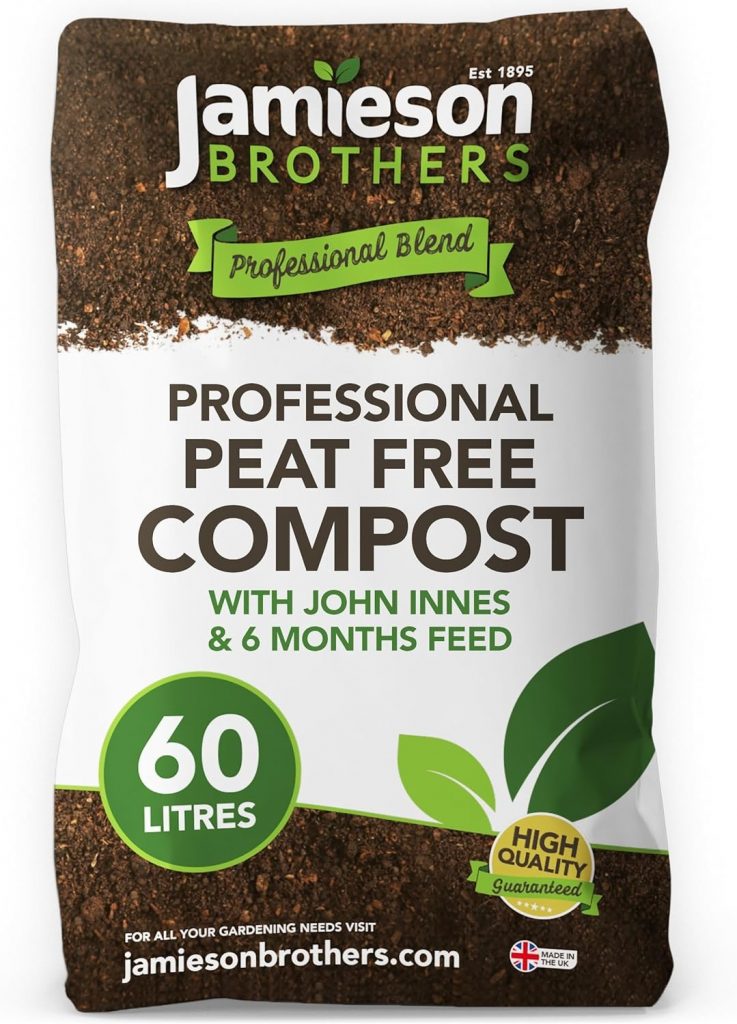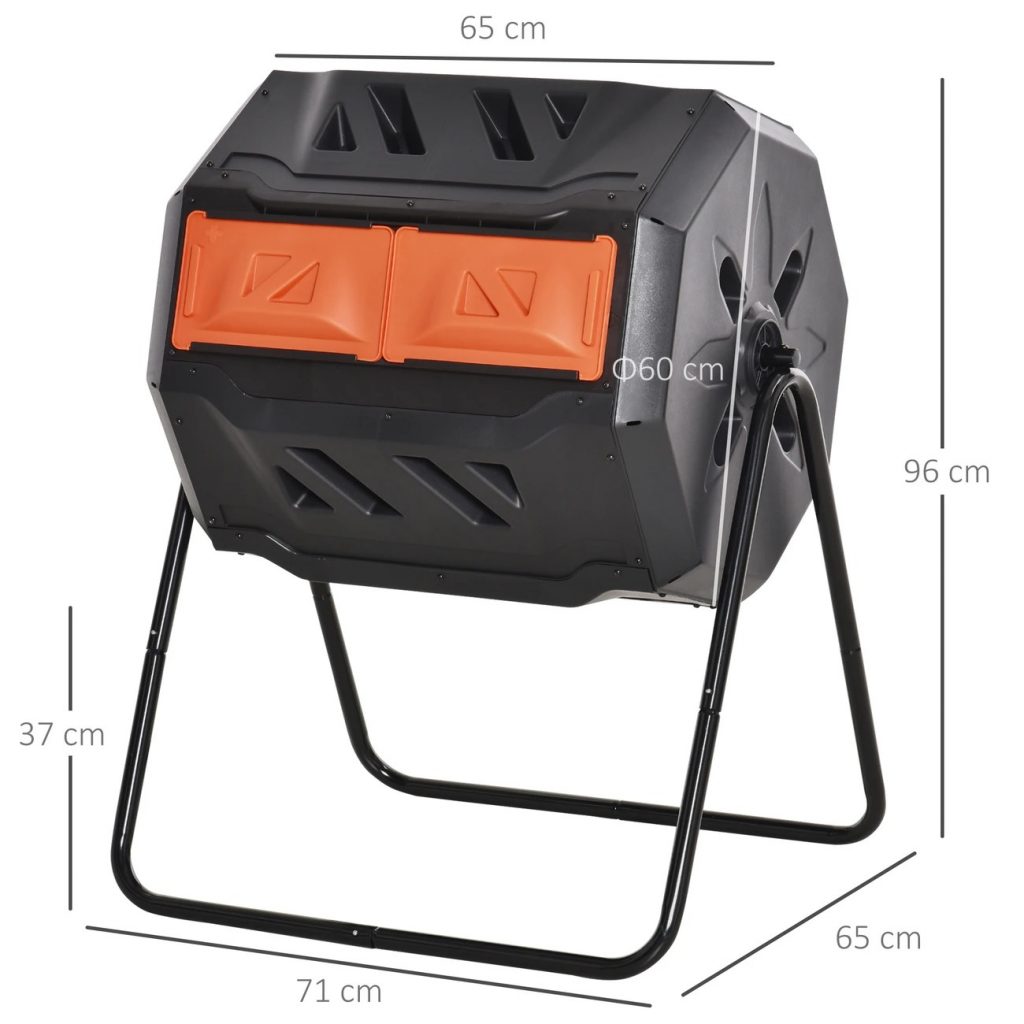For a Thriving Spring Garden
Composting is all about turning kitchen scraps and garden waste into rich, crumbly soil that helps plants bloom.
Why does it matter? Composting cuts waste, saves money, and gives your spring garden a natural boost—no harsh chemicals needed.
Anyone can start, and even kids love getting their hands a little dirty while they learn about the natural world.
This spring, you can take your efforts one step further with Jamieson Brothers seed compost.
This trusted blend supports seeds and young plants, making it simple to enjoy healthy flowers, vegetables, or herbs right outside your door.
Whether you’re curious about worm bins, want to try a compost tumbler, or just need tips on compost, this guide is designed for you.
We’ll walk you through the best practical ways to use Jamieson Brothers seed compost for strong, happy plants and a more sustainable garden.
Along the way, you’ll learn about traditional composting, vermicomposting, and why making compost at home is easier than you think.
For even more tips, check out these ideas for 6 effective composting methods.
Key takeaways:
- Composting turns waste into plant food with less landfill and more savings.
- Jamieson Brothers seed compost helps seeds and seedlings thrive.
- Kids and adults alike can compost at home with simple tools.
- Learning about compost tumblers, vermicomposting, and different methods will help any gardener.
- Using high-quality compost boosts sustainability and garden success.
Why Composting Matters:
The Science and Simple Joys Behind It
 Photo by Greta Hoffman
Photo by Greta Hoffman
When you dig into a bag of Jamieson Brothers seed compost, you’re not just opening up good soil—you’re embracing a cycle that helps the planet, your garden, and even your mood.
Composting is more than a garden trend. It’s a practical science that balances tiny microbes, scraps, and patience, transforming kitchen waste into life-giving soil.
Why does it matter?
Every handful of compost you add unlocks benefits that ripple out from your backyard to the environment and your own wellbeing.
The Science: Turning Waste into a Resource
At its core, composting is recycling. Microorganisms such as bacteria and fungi break down food scraps, leaves, and other organic matter.
This natural process creates humus—a dark, crumbly material that’s full of nutrients.
Using this finished compost improves soil, helping it hold water and nutrients better without needing synthetic fertilizers.
- Compost enriches soil naturally by adding vital nutrients.
- It enhances water retention so you use less water during dry spells.
- It supports a rich soil structure where plant roots thrive.
- Composting reduces landfill waste—yard and kitchen scraps make up about 30% of what we throw away.
Making your own compost at home is a win-win for gardens and the planet. When waste breaks down in landfills, it often produces methane, a potent greenhouse gas.
Compost heaps, bins, and tumblers break down waste with air, limiting methane and improving your ecological footprint.
For more specifics, you can see the science-backed benefits of compost.
Simple Joys: Why Composting Feels Good
Composting isn’t just about soil. It’s about the satisfying feeling you get when you see scraps turn into rich, dark compost.
There’s a cheerful thrill in watching busy worms transform peels and coffee grounds in vermicomposting bins, or in spinning your compost tumbler and smelling that earthy scent that signals healthy decomposition.
Gardeners often say composting connects them with the rhythms of the seasons and the cycle of life. It’s a soothing, hands-on process that kids and adults can share.
Even compost mistakes (like a bin that’s too wet or dry) are easy to fix, and every batch you make is a small success for your garden and your home.
A few ways composting brings simple satisfaction:
- Watching waste disappear and become something useful.
- Saving money on buying extra soil or fertilizer.
- Creating a natural home for worms, beetles, and beneficial microbes.
- Reducing household waste and feeling more eco-friendly.
If you’re just starting, it’s easy to learn—try these tips for starting composting at home.
No fancy tools required, just curiosity and a few kitchen scraps.
Tried-and-True Tools: Vermicomposting and Compost Tumblers
Every gardener has their favorite way to compost.
Some swear by vermicomposting, where red wiggler worms break down food scraps indoors or out, producing worm castings that turbocharge plant growth.
Plenty of folks love compost tumblers, which make turning and aerating compost a breeze, speeding up the whole process.
- Vermicomposting: Perfect for small spaces, easy for kids, and nearly odor-free. Worm castings are packed with nutrients, giving seedlings the best start possible. Check out this helpful overview of vermicomposting benefits.
- Compost tumblers: Keep it neat, quick, and easy to mix. Tumblers are especially handy if you want rich compost but don’t want to wrangle a big pile. For practical insights, see this quick guide to using a compost tumbler.
No matter which method you use, pairing finished compost or Jamieson Brothers seed compost with your garden beds gives seeds and seedlings a gentle, chemical-free start.
Composting in Everyday Life: How It Builds Better Habits
Composting changes how you see waste. Instead of tossing apple cores and eggshells, you turn them into garden gold.
It’s a mindset shift that leads to more mindful living—less throwing away, more renewing and reusing.
Many families join in together, making composting part of daily chores, just like watering plants or feeding pets.
Explore new ideas for green living by joining initiatives like the Don’t Toss It Campaign—a great way to connect with others, find tips, and celebrate small wins in sustainability.
Key Takeaways
- Composting turns leftovers into garden treasure—good for the earth and easy on your wallet.
- Healthy compost boosts soil, helps plants thrive, and cuts down on waste.
- Methods like vermicomposting and compost tumblers suit different homes and spaces.
- Using Jamieson Brothers seed compost gives young plants a jumpstart and works beautifully with your own compost.
- Composting is a positive, practical habit that brings real joy and strengthens your connection to nature.
- For more ideas and seasonal advice, explore helpful guides like Composting Calendar Tips.
Summary
Composting, especially with Jamieson Brothers seed compost, is simple, rewarding, and helps your garden and the planet flourish.
Whether you use a traditional pile, a worm bin, or a compost tumbler, each step is a small act of renewal that makes a big impact.
FAQ
What is composting and why does it matter?
Composting is breaking down organic waste to create rich soil, cutting landfill waste, and helping your plants grow strong.
What tools can make composting easier?
Vermicomposting bins and compost tumblers both speed up the process and keep things tidy—even indoors.
Can anyone try composting—even kids?
Yes! Composting is safe, fun, and easy for all ages, making it perfect for families and schools.
How do I get started?
Save kitchen scraps, choose a bin or tumbler, and start mixing! For a step-by-step guide, visit starting composting at home.
Getting Started:
How to Use Jamieson Brothers Seed Compost for Spring Success
Spring is the best time to give your seeds and young plants a head start. But using Jamieson Brothers seed compost the right way means more than sprinkling it in a pot.
How you mix, water, and apply compost can make the difference between fast sprouts and slow growers.
Here’s how to get it right, even with unpredictable spring weather.
Pro Tips for Mixing and Watering Compost
Getting the perfect structure and the right level of moisture for your seeds is like giving them a comfy bed and just enough water to sip—not swim.
Jamieson Brothers seed compost is designed for seed starting, but a little care goes a long way.
 Photo by Greta Hoffman
Photo by Greta Hoffman
When you open a fresh bag, fluff the compost gently to let in air and break up any clumps. This gives seeds an easy path for root growth.
If you find the compost feels a bit dense, add a handful of perlite or fine sand—especially if you’re using small pots or seed trays.
For moisture, Jamieson Brothers seed compost should be damp but not soggy. Here’s a simple test: squeeze a handful.
If it holds its shape but doesn’t drip, it’s perfect. If it feels dry or falls apart, lightly mist it with water and mix.
If water pools when you squeeze, let it dry out a little before planting.
Spring weather often brings cool, wet days or sudden sunny spells. Adjust your watering to the weather:
- On rainy days, check pots and trays aren’t sitting in water.
- On sunny days, check soil twice daily and water in the morning to avoid drying out.
- Cover seed trays with a clear lid to help keep moisture steady.
Using compost that’s not fully matured or too rich can cause problems for seedlings.
For more detail on the differences in seed composts, see this expert guide which covers how maturity and mix affect results.
If you’re new to composting or want to troubleshoot, ask a composting question for quick help.
Key tips for mixing and watering:
- Fluff compost before use for air and drainage.
- Test compost moisture with the squeeze method.
- Adjust watering to daily weather changes.
- Avoid waterlogged or bone-dry compost.
Using Compost in Pots, Beds, and Containers
Not all garden setups are the same, and neither are all composts or organic mixes.
Jamieson Brothers seed compost is particularly good for pots, trays, and troughs—but it also shines in raised beds or even mixed into your garden soil.
How to get the best results:
- Seed Trays and Pots: Fill trays, gently firm down, and plant seeds as directed. Top off with a light dusting of compost for even sprouting.
- Raised Beds: Mix seed compost into the top 5 cm of soil in early spring. This works well for veggies and flowers started directly in beds.
- Large Containers: Use seed compost mixed 50:50 with multi-purpose compost for best root growth. Too much pure compost can make containers soggy or dense for roots.
Many gardeners wonder if they can use 100% compost for planting.
While tempting, garden experts warn that pure compost (even the best seed composts) can cause water retention problems or “burn” sensitive seedlings due to concentrated nutrients.
A blend is safest, especially for new plants. You can find more on this in this discussion about using 100% compost in containers.
How does Jamieson Brothers compare to other organic composts?
- Consistency: Seed compost has a finer texture than most home composts, preventing clumps that can suffocate tiny roots.
- Balanced nutrients: Unlike some homemade mixes, Jamieson Brothers seed compost is gentle, reducing the risk of root burn, which is common in unfinished compost.
- Organic Options: While many gardeners use their own compost or options like vermicomposting and compost tumblers, seed compost is a safer choice for delicate seeds because it’s free of large debris and weed seeds.
For container gardening and small beds, composting can help you reuse food and garden waste all year.
If you want new ideas about maximizing compost in every part of your garden, check out these tips on using compost in beds and containers.
If you’re looking to experiment with different styles—such as adding vermicompost or using a compost tumbler for your homemade blend—learn more with the 6 effective composting methods guide.
Quick checklist for spring setups:
- Use seed compost on its own for starting seeds in trays.
- Mix with garden soil in raised beds for strong young roots.
- Combine with multi-purpose or home compost in big containers.
- Avoid using only compost in containers to prevent soggy or salty soil.
Key takeaway: Pairing Jamieson Brothers seed compost with the right mixing and watering technique, and matching it to your garden setup, lets your seeds thrive while making the most of all that nutrient-rich compost you’ve worked hard to create.
Advanced Composting: Vermicomposting and Compost Tumblers for Extra Nutrients
Composting goes beyond a simple pile in the corner of the garden. If you want more nutrients and even faster results, there are smarter methods anyone can try, no matter the size of your outdoor space.
Those looking to make the most of Jamieson Brothers seed compost often find adding vermicompost or using a compost tumbler takes their garden results up a level.
These approaches are easy, clean, and super rewarding for beginners and experienced gardeners alike.
Vermicomposting: Let Worms Do the Work
 Photo by Sippakorn Yamkasikorn
Photo by Sippakorn Yamkasikorn
Vermicomposting is like hiring a hungry workforce for your compost bin!
In this method, red wigglers (a special kind of worm) munch on kitchen scraps, turning them into castings—tiny, nutrient-packed granules that plants love.
Why add vermicompost to Jamieson Brothers seed compost? Worm castings act like a vitamin boost for seeds and young roots.
They help with germination and make nutrients more available to plants.
This gentle fertilizer is great for seedlings, pots, and anywhere you want supercharged results without harsh chemicals.
What to love about vermicomposting:
- Odor-free and easy to manage indoors or outdoors.
- Speeds up composting of kitchen scraps, even in winter.
- Creates castings that help seeds sprout faster and grow stronger.
For an in-depth look at why worm composting rocks, check these vermicomposting benefits explained by Joe Gardener. Want to know how to start vermicomposting at home, step by step? Read this home composting guide.
Compost Tumblers: Quick, Clean, and Space-Saving
Not everyone has space for a big compost pile. Compost tumblers offer a tidy and efficient solution that even small gardens or patios can handle.
With a tumbler, you load in your waste, spin the barrel a couple of times a week, and let the natural process take over.
Air and movement help waste break down quicker, so you can harvest finished compost in weeks instead of months.
Here’s what makes compost tumblers a smart option:
- Neat and secure: Locked barrels keep pests out and mess contained.
- Faster results: Regular turning keeps everything warm and aerated. That means quick decomposition for nutrient-rich compost.
- Easy to use: Great for families, schools, or anyone who wants low-effort composting.
Pairing compost from a tumbler with Jamieson Brothers seed compost gives your seedlings a blend of nutrients sourced from your very own kitchen and garden waste.
If you’re wondering where to start, this practical compost tumbler guide from Eartheasy lays out simple steps to compost success.
For more creative approaches to composting, whether you have a balcony or full yard, check out these six effective composting methods.
Why Add Extra Nutrients to Jamieson Brothers Seed Compost?
Even an excellent seed compost like Jamieson Brothers does best when you give it backup from homemade sources.
Vermicompost and tumbler compost add organic matter, living microbes, and a slow-release nutrient boost. This mix ensures your seeds get:
- Gentle nutrition at their earliest stages
- Improved soil structure for roots to spread out
- Better moisture retention during unpredictable spring weather
Getting creative with how you compost not only reduces food waste but also brings extra joy to your spring garden routine.
Whether you start small with a worm bin or roll out a new tumbler, adding these methods to your toolkit makes gardening easier, cleaner, and even more satisfying.
Key Takeaways
- Vermicomposting uses worms to create a gentle, powerful fertilizer for seeds.
- Compost tumblers speed up composting, keep it clean, and make it easy for any space.
- Adding homemade compost to Jamieson Brothers seed compost supports stronger, healthier seedlings.
- Both methods reduce waste and help you get more from every seed and scrap.
- Explore more methods for all spaces in this composting guide.
Smart Composting Habits for a Healthy and Sustainable Garden
Smart composting isn’t about having the biggest pile or the fanciest bin—it’s about thoughtful habits that make your garden thrive while nurturing the earth.
With spring in full swing, these habits work especially well when you incorporate Jamieson Brothers seed compost into your routine.
Composting, vermicomposting, and using a compost tumbler can all become easy parts of daily life, turning scraps into garden gold and reducing waste with almost no extra effort.
Making Composting Part of Everyday Life
Building healthy soil starts with regular composting habits.
You don’t need to overhaul your lifestyle—just set up a few simple routines and you’ll see a greener, happier garden.
- Save kitchen scraps: Keep a small compost bin or a bucket near your sink. Toss in fruit peels, veggie trimmings, eggshells, and coffee grounds. If you’re not sure what goes in, the basics are fruit, veg, and most leftovers, not meat or dairy.
- Feed your pile or bin often: Frequent additions keep composting active and prevent waste build-up. It’s like feeding a pet: little and often is best.
- Mix materials: Alternate “greens” (like food scraps and grass) with “browns” (dry leaves, shredded cardboard). This balance keeps your compost breaking down quickly and avoids any bad smells.
 Photo by SHVETS production
Photo by SHVETS production
- Turn your compost: If you use a pile or a bin, mix it up every couple of weeks. This lets in air, which helps organic matter break down faster.
- With a compost tumbler, just spin it instead—super simple! If you need a refresher on tumbler technique, this quick guide explains step-by-step.
- Watch the moisture: Good compost is like a wrung-out sponge. Too dry? Sprinkle with water. Too wet? Add more dry browns. This will help the microbes and worms do their best work.
Adding Jamieson Brothers seed compost is like sprinkling magic on your seed beds. Blend it lightly with homemade compost for a seedling-friendly start.
It provides reliable texture and nutrients, even if your own compost varies through the seasons.

Go Beyond the Basics with Vermicomposting and Tumblers
Once your basic composting habit is established, try advancing to new methods for even healthier soil and less waste.
- Vermicomposting: Set up a small worm bin in your kitchen, garage, or garden shed. Red wiggler worms love food scraps and make super-rich castings. These castings blend beautifully with seed compost and help roots grow strong from day one.
- Compost tumblers: If you’d like to speed things up or keep everything tidy, a tumbler is perfect. Add your browns and greens, give it a spin every few days, and in weeks you’ve got finished compost. Place your tumbler in a sunny spot to naturally boost the breakdown process; this guide on tumbler placement and use has more detailed pointers.
Both worm bins and tumblers are great for gardeners with limited space or who want a cleaner, faster method than traditional piles.
Reap the Benefits With Sustainable Choices
Smart habits don’t just boost plant health—they shrink your household waste. Less landfill waste means fewer methane emissions, cleaner air, and healthier land.
Home composting also saves money since you don’t need to buy fertilizer or bagged soil as often.
These habits lay the groundwork for a kinder, greener everyday routine:
- You play a direct part in shrinking landfill waste by composting at home (Composting 101 explains how this benefits the earth).
- Kids and adults can join in; composting and worm bins are easy family projects.
- Healthy compost fosters hardy seedlings, rich veggie beds, and pollinator-friendly flowers—especially when you mix in Jamieson Brothers seed compost for an added boost.
Gardeners looking to push their skills further can check out a collection of effective composting methods for all seasons and garden sizes.
You’ll pick up handy tips to avoid pests, get more finished compost, and keep your routine simple.
Key Takeaways
- Composting at home is about steady habits, not perfection.
- A mix of kitchen scraps, garden waste, and seed compost produces the healthiest soil.
- Turning your pile or spinning your tumbler helps speed things up.
- Vermicomposting adds a gentle nutrient kick, and is ideal for small spaces.
- Every banana peel or leaf you compost cuts down on waste and boosts your spring garden.
- Explore more projects in the Don’t Toss It Campaign for ways to build eco-friendly habits into your daily life.
Conclusion
Spring gardening gets a real boost when you use Jamieson Brothers seed compost.
Whether you’re filling seed trays, mixing up soil in containers, or adding nutrients with vermicomposting and a compost tumbler, these practical steps keep your garden healthy and sustainable.
Composting is more than a chore—it feels good to recycle, reduce waste, and watch your plants thrive with each handful you add.
Jamieson Brothers seed compost makes it simple for anyone to grow strong seedlings and fresh food right at home.
Smart composting habits and easy tools like vermicomposting bins and tumblers turn scraps into results you can see each week, from lush lettuce to blooming marigolds.
Try a few changes to your routine and see how small actions make a big impact in your garden and on the environment.
Main takeaways for spring success:
- Jamieson Brothers seed compost is gentle and reliable for seeds and young plants.
- Mixing your compost right and keeping it damp—not soggy—leads to better growth.
- Vermicomposting and compost tumblers offer easy, nutrient-rich ways to support your spring garden.
- Building daily composting habits cuts waste and keeps gardens and families connected to nature.
For more ways to keep your compost routine strong all year, explore the handy Composting Calendar Tips.
Looking for troubleshooting and extra advice?
Try the composting FAQ bot for instant answers.
Thanks for reading and happy composting—your seeds, your garden, and the planet will thank you back!
Frequently Asked Questions:
Jamieson Brothers Seed Compost and Spring Composting
Spring gardening brings a fresh wave of curiosity, especially if you’re considering Jamieson Brothers seed compost for the first time.
Here, let’s tackle some of the most common questions about compost, composting, vermicomposting, and compost tumblers.
Whether you’re a beginner or just need a refresher, this section is designed to help you get the basics right, use seed compost wisely, and make your spring garden shine.
What is composting and why does it matter?
Composting is turning fruit peels, veggie scraps, and yard waste into dark, crumbly soil that helps plants grow.
It’s nature’s way to recycle leftovers into something useful for your garden. When you compost at home, you cut down on rubbish piling up in landfills and give back to the earth at the same time.
Plus, compost keeps your soil healthier without synthetic fertilizers.
A handful of well-made compost is like feeding your garden a super smoothie.
For deeper insight into how composting enriches soil and supports the planet, check out this handy guide: Composting 101.
Can I use Jamieson Brothers seed compost on its own to start seeds?
Yes! Jamieson Brothers seed compost is specially blended for seed starting. You can fill trays or small pots with it for sowing most seeds.
It holds moisture well, is fine-textured for tiny roots, and keeps seedlings from drying out or getting waterlogged.
For bigger plants or containers, mix in some multi-purpose compost for better support as roots grow larger.
What makes vermicomposting different from regular composting?
Vermicomposting uses worms, usually red wigglers, to break down food scraps. These little workers turn kitchen waste into nutrient-rich castings, which are perfect for adding to your garden beds or blending into seed compost.
Worm bins can live inside or outside, making this method great for homes with limited space.
If you’re curious about getting started with worm composting, take a peek at these tips on how to start a vermicompost bin.
Should I use a compost tumbler or a traditional pile?
A compost tumbler works like a big spinning barrel. You load your scraps, give it a turn, and let air work its magic.
Tumblers speed up the process and keep things tidy—especially if you’re short on yard space or want to avoid pests.
A traditional pile is low-cost and works well if you have space and don’t mind occasional turning with a pitchfork.
Both make beautiful compost; your choice depends on how much space, time, and mess you have room for.
How can I tell if my compost or worm castings are ready to use with Jamieson Brothers seed compost?
Finished compost looks and smells like fresh soil. It’s loose, crumbly, and dark brown or black. You won’t see big chunks of old food or leaves.
If you’re using a vermicomposting bin, worm castings are small, grainy particles—no strong odor.
Mix a small amount of mature compost or castings into your Jamieson Brothers seed compost to give your seedlings a gentle nutritional kick.
What’s the best way to recycle kitchen scraps at home?
Start with a bin or small pile outside or a countertop caddy for collecting scraps. Layer food waste with dry leaves or shredded cardboard to avoid smells and sogginess.
Need a step-by-step kitchen setup? See this guide to make compost at home using everyday food scraps.
Can composting help save money or reduce waste?
Absolutely! Making your own compost saves trips to the garden center and trims down the rubbish you send to the dump.
Plus, compost adds life to your garden beds, meaning fewer chemicals and healthier veggies. Learn more about compost’s everyday benefits in this article covering the top five reasons to compost.
What if my compost gets smelly or soggy?
Too much food waste without enough dry matter (leaves, cardboard) can make compost wet and stinky.
Just add more dry materials and give it a good mix or tumble to get air inside. This balances the moisture and speeds up decomposition.
How much Jamieson Brothers seed compost do I need?
A small bag will easily fill a few seed trays or a set of starter pots.
For direct sowing in garden beds, mix a layer of seed compost into the top few centimeters of soil.
Large projects or container gardens need more—never be afraid to start small and add as you go.
Any safety tips for composting at home?
Wash hands after handling compost, especially for kids, and wear gloves if you have cuts or sensitive skin.
Keep meat, dairy, and oily foods out of your bin to avoid pests and unwanted smells.
Compost bins and tumblers should be placed in a spot that’s easy to reach but not in full, beating sun all day.
Key Takeaways
- Jamieson Brothers seed compost gives seeds a strong, safe start in pots, trays, and beds.
- Composting and vermicomposting turn kitchen and yard scraps into rich soil for free.
- Compost tumblers offer a clean, quick way to recycle waste if you’re short on yard space.
- Layering “greens” (food scraps) with “browns” (leaves, cardboard) keeps compost healthy.
- Use only mature compost or worm castings with seed compost to help young plants grow strong.
- Home composting reduces waste, saves money, and helps the environment.
- Explore more ways to get started with the kitchen waste composting guide.
FAQ
Do I need special tools to start composting at home?
No special tools are needed—just a bin or a corner of your yard. Compost tumblers or worm bins can help but aren’t required.
Can I compost in winter?
Yes! Composting slows down in cold months, but using a compost tumbler or keeping a worm bin indoors means you can keep recycling scraps all year.
Is homemade compost safe for vegetables and kids’ gardens?
Yes, as long as your compost is finished (looks and smells like soil). Mature compost is safe for edible plants and children’s gardens.
How do I know which composting method is right for me?
Consider your space, time, and scraps. For a simple start, try a small outdoor bin or a basic worm bin. For a cleaner, quicker system, a compost tumbler is ideal.
If you have more questions, there’s always friendly advice waiting at the Composting FAQ bot.
 Photo By: Kaboompics.com
Photo By: Kaboompics.com








